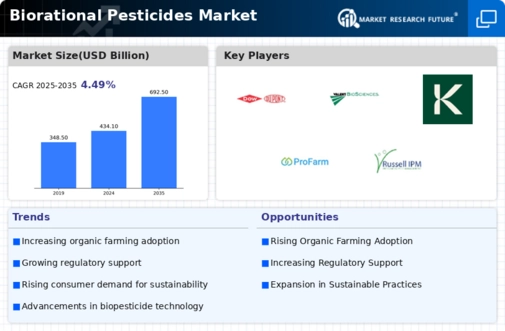-
Executive Summary
-
Scope of the Report
-
Market Definition
-
Scope of the Study
- Research Objectives
- Assumptions & Limitations
-
Market Structure
-
Market Research Methodology
-
Research Process
-
Secondary Research
-
Primary Research
-
Forecast Model
-
Market Landscape
-
Supply Chain Analysis
- Raw Material Suppliers
- Manufacturers/Producers
- Distributors/Retailers/Wholesalers/E-Commerce
- End Users
-
Porter’s Five Forces Analysis
- Threat of New Entrants
- Bargaining Power of Buyers
- Bargaining Power of Suppliers
- Threat of Substitutes
- Internal Rivalry
-
Market Dynamics of Global Biorational Pesticides Market
-
Introduction
-
Drivers
-
Restraints
-
Opportunities
-
Challenges
-
Global Biorational Pesticides Market, by Source
-
Introduction
-
Botanical
- Market Estimates & Forecast, 2021-2028
- Market Estimates & Forecast, by Region, 2021-2028
-
Microbials
- Market Estimates & Forecast, 2021-2028
- Market Estimates & Forecast, by Region, 2021-2028
-
Minerals
- Market Estimates & Forecast, 2021-2028
- Market Estimates & Forecast, by Region, 2021-2028
-
Others
- Market Estimates & Forecast, 2021-2028
- Market Estimates & Forecast, by Region, 2021-2028
-
Global Biorational Pesticides Market, by Mode of Application
-
Introduction
-
Foliar Spray
- Market Estimates & Forecast, 2021-2028
- Market Estimates & Forecast, by Region, 2021-2028
-
Soil Treatment
- Market Estimates & Forecast, 2021-2028
- Market Estimates & Forecast, by Region, 2021-2028
-
Trunk Injection
- Market Estimates & Forecast, 2021-2028
- Market Estimates & Forecast, by Region, 2021-2028
-
Others
- Market Estimates & Forecast, 2021-2028
- Market Estimates & Forecast, by Region, 2021-2028
-
Global Biorational Pesticides Market, by Type
-
Introduction
-
Biorational Insecticides
- Market Estimates & Forecast, 2021-2028
- Market Estimates & Forecast, by Region, 2021-2028
-
Biorational Fungicides
- Market Estimates & Forecast, 2021-2028
- Market Estimates & Forecast, by Region, 2021-2028
-
Biorational Nematicides
- Market Estimates & Forecast, 2021-2028
- Market Estimates & Forecast, by Region, 2021-2028
-
Others
- Market Estimates & Forecast, 2021-2028
- Market Estimates & Forecast, by Region, 2021-2028
-
Global Biorational Pesticides Market, by Crop Type
-
Introduction
-
Fruits & Vegetables
- Market Estimates & Forecast, 2021-2028
- Market Estimates & Forecast, by Region, 2021-2028
-
Cereals & Grains
- Market Estimates & Forecast, 2021-2028
- Market Estimates & Forecast, by Region, 2021-2028
-
Oilseeds & Pulses
- Market Estimates & Forecast, 2021-2028
- Market Estimates & Forecast, by Region, 2021-2028
-
Others
- Market Estimates & Forecast, 2021-2028
- Market Estimates & Forecast, by Region, 2021-2028
-
Global Biorational Pesticides Market, by Region
-
Introduction
-
North America
- Market Estimates & Forecast, 2021-2028
- Market Estimates & Forecast, by Source, 2021-2028
- Market Estimates & Forecast, by Mode of Application, 2021-2028
- Market Estimates & Forecast, by Type, 2021-2028
- Market Estimates & Forecast, by Crop Type, 2021-2028
- US
- Canada
- Mexico
-
Europe
- Market Estimates & Forecast, 2021-2028
- Market Estimates & Forecast, by Source, 2021-2028
- Market Estimates & Forecast, by Mode of Application, 2021-2028
- Market Estimates & Forecast, by Type, 2021-2028
- Market Estimates & Forecast, by Crop Type, 2021-2028
- Germany
- France
- Italy
- Spain
- UK
- Rest of Europe
-
Asia-Pacific
- Market Estimates & Forecast, 2021-2028
- Market Estimates & Forecast, by Source, 2021-2028
- Market Estimates & Forecast, by Mode of Application, 2021-2028
- Market Estimates & Forecast, by Type, 2021-2028
- Market Estimates & Forecast, by Crop Type, 2021-2028
- China
- India
- Japan
- Australia & New Zealand
- Rest of Asia-Pacific
-
Rest of the World (RoW)
- Market Estimates & Forecast, 2021-2028
- Market Estimates & Forecast, by Source, 2021-2028
- Market Estimates & Forecast, by Mode of Application, 2021-2028
- Market Estimates & Forecast, by Type, 2021-2028
- Market Estimates & Forecast, by Crop Type, 2021-2028
- South America
- The Middle East
- Africa
-
Company Landscape
-
Introduction
-
Market Strategy
-
Key Development Analysis
-
(Expansions/ Mergers and Acquisitions/ Joint Ventures/ New Product Developments/ Agreements/ Investments
-
Company Profiles
-
Bayer Cropscience
- Company Overview
- Financial Updates
- Product/Business Segment Overview
- Strategy
- Key Developments
- SWOT Analysis
-
Syngenta
- Company Overview
- Financial Updates
- Product/Business Segment Overview
- Strategy
- Key Developments
- SWOT Analysis
-
Monsanto Bioag
- Company Overview
- Financial Updates
- Product/Business Segment Overview
- Strategy
- Key Developments
- SWOT Analysis
-
BASF SE
- Company Overview
- Financial Updates
- Product/Business Segment Overview
- Strategy
- Key Developments
- SWOT Analysis
-
Dowdupont
- Company Overview
- Financial Updates
- Product/Business Segment Overview
- Strategy
- Key Developments
- SWOT Analysis
-
Valent Biosciences
- Company Overview
- Financial Updates
- Product/Business Segment Overview
- Strategy
- Key Developments
- SWOT Analysis
-
Isagro SAP
- Company Overview
- Financial Updates
- Product/Business Segment Overview
- Strategy
- Key Developments
- SWOT Analysis
-
Koppert
- Company Overview
- Financial Updates
- Product/Business Segment Overview
- Strategy
- Key Developments
- SWOT Analysis
-
Marrone Bio Innovations
- Company Overview
- Financial Updates
- Product/Business Segment Overview
- Strategy
- Key Developments
- SWOT Analysis
-
Russell IPM
- Company Overview
- Financial Updates
- Product/Business Segment Overview
- Strategy
- Key Developments
- SWOT Analysis
-
Conclusion
-
LIST OF TABLES
-
Global Biorational Pesticides Market, by Region, 2021-2028 (USD Million)
-
Global Biorational Pesticides Market, by Source, 2021-2028 (USD Million)
-
Global Biorational Pesticides Market, by Mode of Mode of Application, 2021-2028 (USD Million)
-
Global Biorational Pesticides Market, by Type, 2021-2028 (USD Million)
-
Global Biorational Pesticides Market, by Crop Type, 2021-2028 (USD Million)
-
North America: Starch Derivatives Market, by Country, 2021-2028 (USD Million)
-
North America: Starch Derivatives Market, by Source, 2021-2028 (USD Million)
-
North America: Starch Derivatives Market, by Mode of Mode of Application, 2021-2028 (USD Million)
-
North America: Starch Derivatives Market, by Type, 2021-2028 (USD Million)
-
North America: Starch Derivatives Market, by Crop Type, 2021-2028 (USD Million)
-
US: Starch Derivatives Market, by Source, 2021-2028 (USD Million)
-
US: Starch Derivatives Market, by Mode of Mode of Application, 2021-2028 (USD Million)
-
US: Starch Derivatives Market, by Type, 2021-2028 (USD Million)
-
US: Starch Derivatives Market, by Crop Type, 2021-2028 (USD Million)
-
Canada: Starch Derivatives Market, by Source, 2021-2028 (USD Million)
-
Canada: Starch Derivatives Market, by Mode of Mode of Application, 2021-2028 (USD Million)
-
Canada: Starch Derivatives Market, by Type, 2021-2028 (USD Million)
-
Canada: Starch Derivatives Market, by Crop Type, 2021-2028 (USD Million)
-
Mexico: Starch Derivatives Market, by Source, 2021-2028 (USD Million)
-
Mexico: Starch Derivatives Market, by Mode of Mode of Application, 2021-2028 (USD Million)
-
Mexico: Starch Derivatives Market, by Type, 2021-2028 (USD Million)
-
Mexico: Starch Derivatives Market, by Crop Type, 2021-2028 (USD Million)
-
Europe: Starch Derivatives Market, by Country, 2021-2028 (USD Million)
-
Europe: Starch Derivatives Market, by Source, 2021-2028 (USD Million)
-
Europe: Starch Derivatives Market, by Mode of Mode of Application, 2021-2028 (USD Million)
-
Europe: Starch Derivatives Market, by Type, 2021-2028 (USD Million)
-
Europe: Starch Derivatives Market, by Crop Type, 2021-2028 (USD Million)
-
Germany: Starch Derivatives Market, by Source, 2021-2028 (USD Million)
-
Germany: Starch Derivatives Market, by Mode of Mode of Application, 2021-2028 (USD Million)
-
Germany: Starch Derivatives Market, by Type, 2021-2028 (USD Million)
-
Germany: Starch Derivatives Market, by Crop Type, 2021-2028 (USD Million)
-
France: Starch Derivatives Market, by Source, 2021-2028 (USD Million)
-
France: Starch Derivatives Market, by Mode of Mode of Application, 2021-2028 (USD Million)
-
France: Starch Derivatives Market, by Type, 2021-2028 (USD Million)
-
France: Starch Derivatives Market, by Crop Type, 2021-2028 (USD Million)
-
Italy: Starch Derivatives Market, by Source, 2021-2028 (USD Million)
-
Italy: Starch Derivatives Market, by Mode of Mode of Application, 2021-2028 (USD Million)
-
Italy: Starch Derivatives Market, by Type, 2021-2028 (USD Million)
-
Italy: Starch Derivatives Market, by Crop Type, 2021-2028 (USD Million)
-
Spain: Starch Derivatives Market, by Source, 2021-2028 (USD Million)
-
Spain: Starch Derivatives Market, by Mode of Mode of Application, 2021-2028 (USD Million)
-
Spain: Starch Derivatives Market, by Type, 2021-2028 (USD Million)
-
Spain: Starch Derivatives Market, by Crop Type, 2021-2028 (USD Million)
-
UK: Starch Derivatives Market, by Source, 2021-2028 (USD Million)
-
UK: Starch Derivatives Market, by Mode of Application, 2021-2028 (USD Million)
-
UK: Starch Derivatives Market, by Type, 2021-2028 (USD Million)
-
UK: Starch Derivatives Market, by Crop Type, 2021-2028 (USD Million)
-
Rest of Europe: Starch Derivatives Market, by Source, 2021-2028 (USD Million)
-
Rest of Europe: Starch Derivatives Market, by Mode of Application, 2021-2028 (USD Million)
-
Rest of Europe: Starch Derivatives Market, by Type, 2021-2028 (USD Million)
-
Rest of Europe: Starch Derivatives Market, by Crop Type, 2021-2028 (USD Million)
-
Asia-Pacific: Starch Derivatives Market, by Country, 2021-2028 (USD Million)
-
Asia-Pacific: Starch Derivatives Market, by Source, 2021-2028 (USD Million)
-
Asia-Pacific: Starch Derivatives Market, by Mode of Application, 2021-2028 (USD Million)
-
Asia-Pacific: Starch Derivatives Market, by Type, 2021-2028 (USD Million)
-
Asia-Pacific: Starch Derivatives Market, by Crop Type, 2021-2028 (USD Million)
-
China: Starch Derivatives Market, by Source, 2021-2028 (USD Million)
-
China: Starch Derivatives Market, by Mode of Application, 2021-2028 (USD Million)
-
China: Starch Derivatives Market, by Type, 2021-2028 (USD Million)
-
China: Starch Derivatives Market, by Crop Type, 2021-2028 (USD Million)
-
India: Starch Derivatives Market, by Source, 2021-2028 (USD Million)
-
India: Starch Derivatives Market, by Mode of Application, 2021-2028 (USD Million)
-
India: Starch Derivatives Market, by Type, 2021-2028 (USD Million)
-
India: Starch Derivatives Market, by Crop Type, 2021-2028 (USD Million)
-
Japan: Starch Derivatives Market, by Source, 2021-2028 (USD Million)
-
Japan: Starch Derivatives Market, by Mode of Application, 2021-2028 (USD Million)
-
Japan: Starch Derivatives Market, by Type, 2021-2028 (USD Million)
-
Japan: Starch Derivatives Market, by Crop Type, 2021-2028 (USD Million)
-
Australia and New Zealand: Starch Derivatives Market, by Source, 2021-2028 (USD Million)
-
Australia and New Zealand: Starch Derivatives Market, by Mode of Application, 2021-2028 (USD Million)
-
Australia and New Zealand: Starch Derivatives Market, by Type, 2021-2028 (USD Million)
-
Australia and New Zealand: Starch Derivatives Market, by Crop Type, 2021-2028 (USD Million)
-
Rest of Asia-Pacific: Starch Derivatives Market, by Source, 2021-2028 (USD Million)
-
Rest of Asia-Pacific: Starch Derivatives Market, by Mode of Application, 2021-2028 (USD Million)
-
Rest of Asia-Pacific: Starch Derivatives Market, by Type, 2021-2028 (USD Million)
-
Rest of Asia-Pacific: Starch Derivatives Market, by Crop Type, 2021-2028 (USD Million)
-
Rest of the World (RoW): Starch Derivatives Market, by Country, 2021-2028 (USD Million)
-
Rest of the World (RoW): Starch Derivatives Market, by Source, 2021-2028 (USD Million)
-
Rest of the World (RoW): Starch Derivatives Market, by Mode of Application, 2021-2028 (USD Million)
-
Rest of the World (RoW): Starch Derivatives Market, by Type, 2021-2028 (USD Million)
-
Rest of the World (RoW): Starch Derivatives Market, by Crop Type, 2021-2028 (USD Million)
-
South America: Starch Derivatives Market, by Source, 2021-2028 (USD Million)
-
South America: Starch Derivatives Market, by Mode of Application, 2021-2028 (USD Million)
-
South America: Starch Derivatives Market, by Type, 2021-2028 (USD Million)
-
South America: Starch Derivatives Market, by Crop Type, 2021-2028 (USD Million)
-
Middle East: Starch Derivatives Market, by Source, 2021-2028 (USD Million)
-
Middle East: Starch Derivatives Market, by Mode of Application, 2021-2028 (USD Million)
-
Middle East: Starch Derivatives Market, by Type, 2021-2028 (USD Million)
-
Middle East: Starch Derivatives Market, by Crop Type, 2021-2028 (USD Million)
-
Africa: Starch Derivatives Market, by Source, 2021-2028 (USD Million)
-
Africa: Starch Derivatives Market, by Mode of Application, 2021-2028 (USD Million)
-
Africa: Starch Derivatives Market, by Type, 2021-2028 (USD Million)
-
Africa: Starch Derivatives Market, by Crop Type, 2021-2028 (USD Million)
-
LIST OF FIGURES
-
Global Biorational Pesticides Market Segmentation
-
Forecast Research Methodology
-
Five Forces Analysis of Global Biorational Pesticides Market
-
Value Chain of Global Biorational Pesticides Market
-
Share of Global Biorational Pesticides Market in 2021, by Country (%)
-
Global Biorational Pesticides Market, by Region, 2021-2028,
-
Global Biorational Pesticides Market Size, by Source, 2021
-
Share of Global Biorational Pesticides Market, by Source, 2021-2028 (%)
-
Global Biorational Pesticides Market Size, by Mode of Application, 2021
-
Share of Global Biorational Pesticides Market, by Mode of Application, 2021-2028 (%)
-
Global Biorational Pesticides Market Size, by Type, 2021
-
Share of Global Biorational Pesticides Market, by Type, 2021-2028 (%)
-
Global Biorational Pesticides Market Size, by Crop Type, 2021
-
Share of Global Biorational Pesticides Market, by Crop Type, 2021-2028 (%)

















Leave a Comment